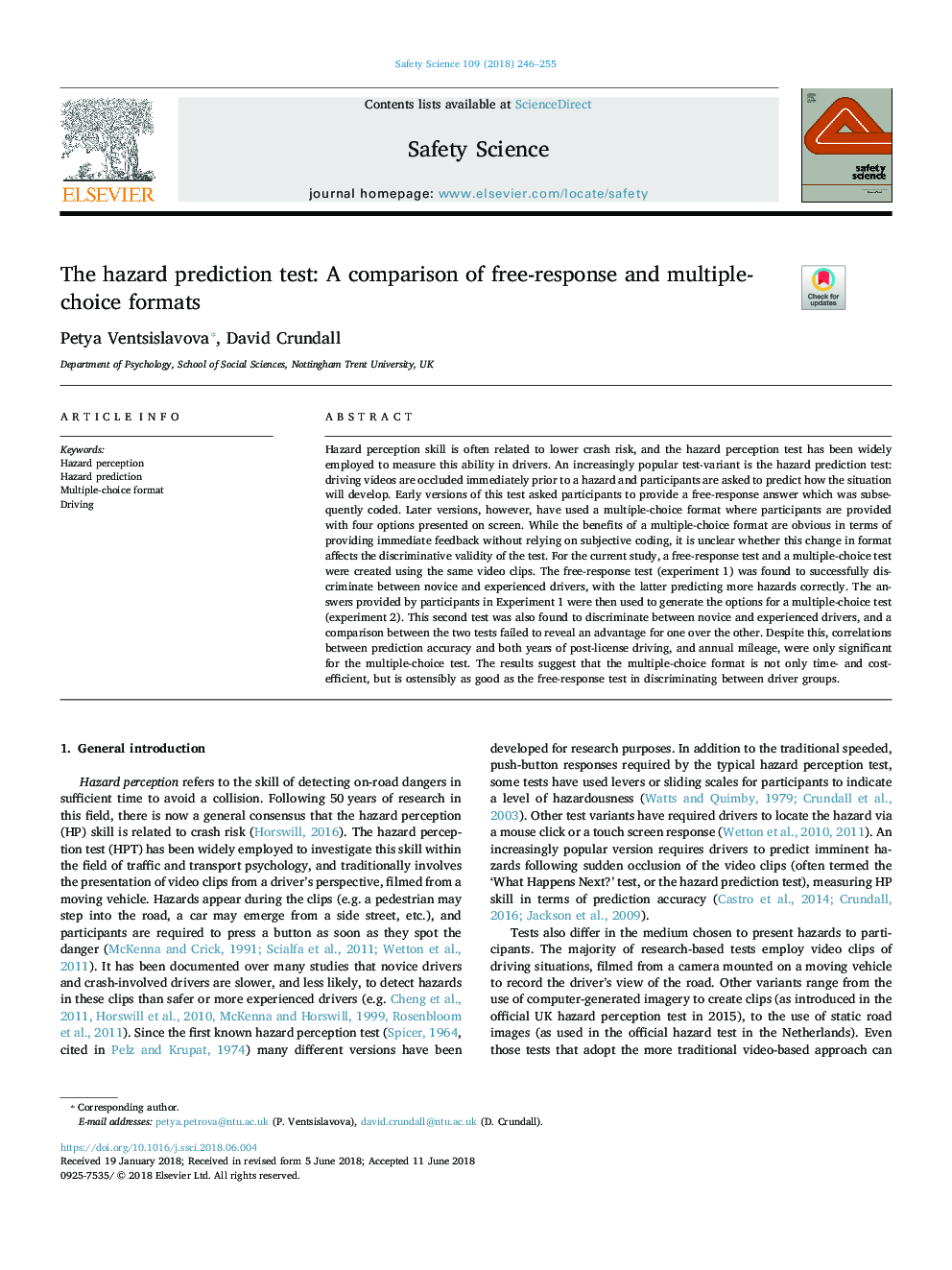| کد مقاله | کد نشریه | سال انتشار | مقاله انگلیسی | نسخه تمام متن |
|---|---|---|---|---|
| 6974708 | 1453363 | 2018 | 10 صفحه PDF | دانلود رایگان |
عنوان انگلیسی مقاله ISI
The hazard prediction test: A comparison of free-response and multiple-choice formats
ترجمه فارسی عنوان
تست پیش بینی خطر: مقایسۀ فرمول های پاسخ آزاد و چند گزینه ای
دانلود مقاله + سفارش ترجمه
دانلود مقاله ISI انگلیسی
رایگان برای ایرانیان
کلمات کلیدی
درک مخاطره، پیش بینی خطر، فرمت انتخاب چندگانه، رانندگی،
ترجمه چکیده
مهارت ادراک مخاطره اغلب به ریسک سقوط کمتر مربوط است و برای اندازه گیری این توانایی در رانندگان، آزمون تصوری خطر به طور گسترده ای مورد استفاده قرار گرفته است. یک آزمایش تکراری به طور فزاینده ای، آزمون پیش بینی خطر است: فیلم های رانندگی بلافاصله قبل از یک خطر بسته می شوند و از شرکت کنندگان خواسته می شود پیش بینی وضعیت چرخه را پیش بینی کنند. نسخه های اولیه این آزمون از شرکت کنندگان خواسته بودند پاسخ پاسخ رایگان پاسخ دهند که بعدا کد گذاری شده بود. نسخه های بعد، با این حال، از فرمت چند گزینه ای استفاده کرده اند که در آن شرکت کنندگان با چهار گزینه ارائه شده بر روی صفحه نمایش ارائه می شوند. در حالی که مزایای یک قالب چند گزینه ای از لحاظ ارائه بازخورد فوری بدون تکیه بر برنامه نویسی ذهنی واضح است، مشخص نیست که آیا این تغییر در قالب بر اعتبار تبعیض آمیز آزمون تاثیر می گذارد. برای مطالعه کنونی، یک آزمون پاسخ آزاد و یک آزمون چند گزینه ای با استفاده از کلیپ های ویدیویی مشابه ایجاد شد. آزمایش آزمایشی رایگان (آزمایش 1) موفق به تشخیص بین رانندگان تازه کار و با تجربه شد، با این که پیش بینی های بیشتر خطرات را به درستی انجام می داد. پاسخ ها ارائه شده توسط شرکت کنندگان در آزمایش 1 سپس برای تولید گزینه برای آزمون چند گزینه ای (آزمایش 2) استفاده می شود. این آزمایش دوم همچنین نشان داد که بین نوازندگان و رانندگان با تجربه تفاوت می کند و مقایسه بین دو آزمایش موفق به نشان دادن مزایایی برای یکی دیگر از دیگر نشد. با وجود این، همبستگی بین دقت پیش بینی و هر دو سال رانندگی پس از مجوز و مسافت پیموده شده سالانه فقط برای آزمون چند گزینه ای قابل توجه بود. نتایج نشان می دهد که فرمت چند گزینه نه تنها زمان و مقرون به صرفه است، بلکه ظاهرا همانند آزمون آزادی پاسخ در تبعیض بین گروه های راننده است.
موضوعات مرتبط
مهندسی و علوم پایه
مهندسی شیمی
بهداشت و امنیت شیمی
چکیده انگلیسی
Hazard perception skill is often related to lower crash risk, and the hazard perception test has been widely employed to measure this ability in drivers. An increasingly popular test-variant is the hazard prediction test: driving videos are occluded immediately prior to a hazard and participants are asked to predict how the situation will develop. Early versions of this test asked participants to provide a free-response answer which was subsequently coded. Later versions, however, have used a multiple-choice format where participants are provided with four options presented on screen. While the benefits of a multiple-choice format are obvious in terms of providing immediate feedback without relying on subjective coding, it is unclear whether this change in format affects the discriminative validity of the test. For the current study, a free-response test and a multiple-choice test were created using the same video clips. The free-response test (experiment 1) was found to successfully discriminate between novice and experienced drivers, with the latter predicting more hazards correctly. The answers provided by participants in Experiment 1 were then used to generate the options for a multiple-choice test (experiment 2). This second test was also found to discriminate between novice and experienced drivers, and a comparison between the two tests failed to reveal an advantage for one over the other. Despite this, correlations between prediction accuracy and both years of post-license driving, and annual mileage, were only significant for the multiple-choice test. The results suggest that the multiple-choice format is not only time- and cost-efficient, but is ostensibly as good as the free-response test in discriminating between driver groups.
ناشر
Database: Elsevier - ScienceDirect (ساینس دایرکت)
Journal: Safety Science - Volume 109, November 2018, Pages 246-255
Journal: Safety Science - Volume 109, November 2018, Pages 246-255
نویسندگان
Petya Ventsislavova, David Crundall,
